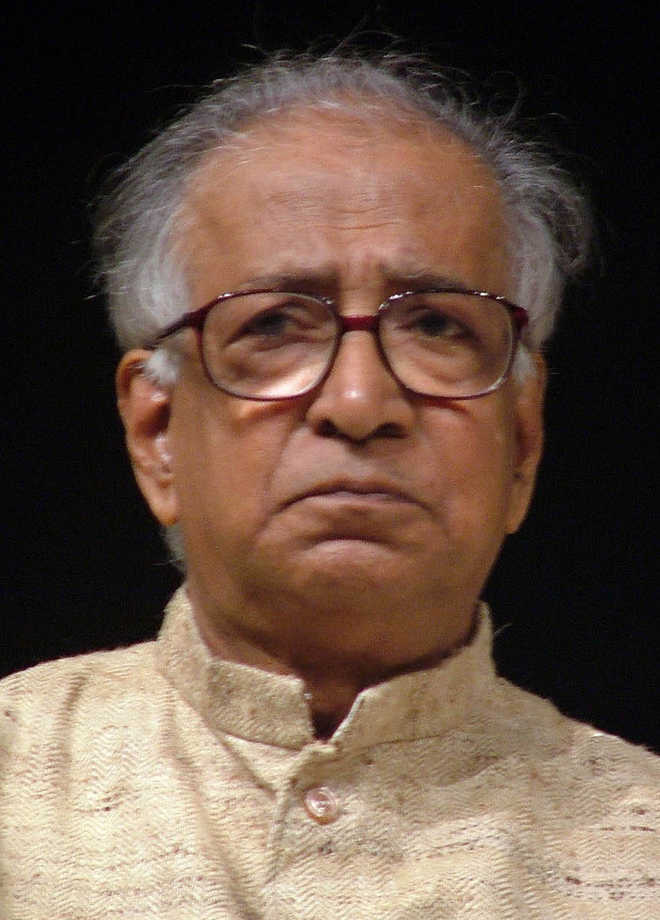
BN Goswamy
Long years ago, I heard Ravindra Jain, the blind musician, speak of the passing away of a great singer, one of the Dagar brothers, I think, quoting this verse: maathey pey shams aanknon mein taaron ki ziyaa thi/ woh bujh gaya ki jis ney zamaane ko jilaa di (the Sun shone on his brow, and stars used to dance and glow in his eyes. He whose presence lit up the world around him is now, however, gone. Extinguished.)
I still do not know who wrote those words, but, almost unthinkingly, they rang in my mind when I heard of the passing away of Kalpathi Ganpathi Subramanyan — “Mani-da”, as everyone used to call him. We all knew he was not going to live forever, but the world seems suddenly to have diminished a bit with his going. Not only the world of art — painting, sculpture, murals, terracotta, writing, tale-telling in visual terms, and so much more — but that of thought, and of humanity.
Mani-da was truly an icon: a path-breaker, a bit of a rebel, a modernist steeped in the Indian tradition. But, somehow, I am more inclined at this time to ‘recall’ his presence, savour those moments; and share something of the ‘feel’ of that uncommon man. I did not see him very often, nor did I get the chance of spending stretches of time with him, but three occasions come vividly to mind. The very first when I went to Baroda — that is what the town used to be called before it turned into Vadodara — where he was head of the Faculty of Fine Arts at the university. He was charm personified: most simply dressed, keen of look, sharp of observation, and incredibly refined in the words he used. There was an aura of brilliance around him that one could instantly sense. We conversed for a while and I noticed that laughter, in short, almost soundless, snatches, came readily to him.
He did not know me or my work, a young and new entrant as I then was in the world of art history, but as we spoke, he seemed to take deep interest in what I had been doing and did not take a moment before deciding to ask me to meet his class and spend time with his boys and girls. Why, he did not say.
A few years later, I invited him to a seminar in our newly established Department of Art History at Panjab University. To that seminar also came celebrated scholars such as Karl Khandalavala and Kapila Vatsyayan. The session in which Mani-da was to make his presentation he opened with a ‘story’. In Shantiniketan — where he studied and taught for many years — he said was a nameless blind man who used to walk his slow walk on narrow paths beside their homes and classrooms, but every now and then he would stop to clap his hands. We always thought, Mani-da said, that this was a personal quirk, something that gave him some private joy. One day, however, we decided to ask him about his clapping. I clap, he said, because through the echo of that sound I can judge where I am: near a structure that I might run into or on a vacant path that I can keep walking on without fear. Seminars, Mani-da said, were like the clapping of the blind man: they enable us to evaluate where we are. After that, he went on to make his presentation.
In my column for The Tribune, for three successive days, I wrote on some of the celebrities who were in our midst, accompanied of course by a photograph, taken, if I recall correctly, by Yog Joy. One article was on Mani-da. He saw it the next morning, took me aside and whispered conspiratorially with a chuckle: “I am going to take this to show it to my wife to prove to her how presentable I can look.” Not a word about the article.
The last time I saw Mani-da was in Bangalore, five or so years back. I was lecturing for the Sanskriti Foundation on a series of paintings that I had been writing on, or researching. Two minutes into the lecture, I noticed a figure slip quietly into the darkened hall and take a seat in a corner. I could see people around him bustling a bit, greeting him, half-rising in their seats, but I could not make out who it was. When, finally, the lights came on, I saw that it was Mani-da.
I hastened down to greet him. “Aap yahaan?” I asked, for Bangalore was not his city. With incredible warmth, he shook my hand. And then said: “Din bhar kuchh acchha nahin kiya; main ney socha chalo kuchh acchha karte hain ab. Aapko suntey hain.” There was that old smile on his face and pleasure in his voice. And he left me with joy in my heart.
The writer is a noted art historian



























